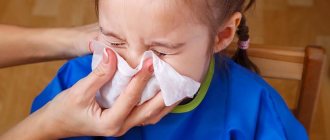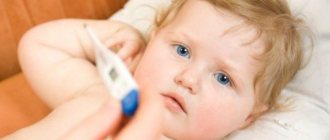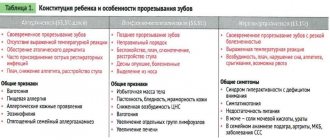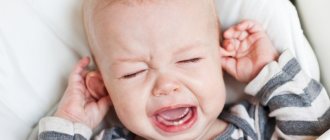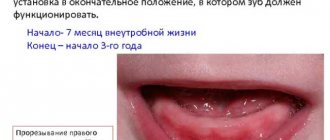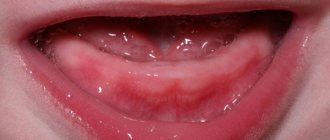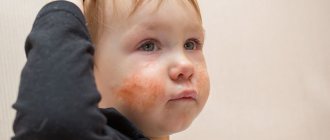Teething in children is accompanied by various painful conditions, one of which is cough. Please note that this symptom is not always observed. Depending on the nature of the cough, you can understand whether it is the result of a disease or is associated with the appearance of teeth.
In most cases, a wet cough during the eruption of the first teeth in babies provokes active salivation; it goes away within a few days and does not require special treatment. It is necessary to examine the skin in the area of the baby's mouth - you can often see irritation caused by saliva. This is a sign that the cough is caused by an expectorant reflex triggered by teething.
If the cough is accompanied by a runny nose, wheezing and shortness of breath, and it does not go away for more than two days, you should consult a medical specialist. The presence of such problems may be a sign of a disease.
Please note that a dry cough may also be present at this time. It is usually caused by the baby crying for a long time and nasal congestion.
Guide to action for moms and dads, grandparents
To ensure that phenomena such as a runny nose and cough cause minimal discomfort to your baby, try to take care of a few points:
- maintain an optimal level of air humidity in the room: so that the cough is not dry and goes away easily, maintain a suitable microclimate in the room where the child is most often located. The room needs to be ventilated more often (naturally, we take the child out of the room), maintain air humidity in it at 40-60% - for this you can purchase an air humidifier or use the old folk method and place containers of water in the room near the heating devices. It is also advisable to carry out wet cleaning of the apartment every day, wiping not only the floors, but also shelves, toys,
- Buy an aspirator: with its help you can easily remove mucus from the nose of those babies who have not yet learned to blow their nose on their own. Today, pharmacies sell electrical, mechanical and vacuum aspirators. If you don’t want to spend money on an aspirator, then you can use a regular small enema as a “nozzle sucker.” The aspirator will help get rid of mucus in the nose
- Give the baby warm liquids, but feed only on demand: if the child doesn’t want to eat, don’t force him,
- do not wrap your baby so as not to cause an increase in body temperature,
- arrange more walks in the fresh air with your child, even in winter (but only if there is no temperature),
- moisturize the mucous membrane of the nose with saline solutions, you can also do inhalations with saline solution,
- prepare the sleeping place correctly: to prevent drool from entering the nasopharynx during sleep and to allow breathing to be free, slightly raise the baby’s sleeping place (about 15 degrees). You can use a large pillow for these purposes or additionally place something under the children's mattress in the place where the baby's head will be,
- speed up the teething process: buy a silicone brush to care for the first teeth and gently massage the baby’s mucous membrane with it. Invest in cooling teethers and pacifiers. Silicone teethers will help your baby during this period
And the most important thing that is required from caring parents is attention and patience towards their kids. After all, only your love and care will help the little ones get through this difficult period.
And if you suspect that cough and snot are the causes of colds or other diseases, and are not at all associated with teething, be sure to contact a pediatrician who will prescribe adequate treatment. This is especially worth doing if the cough has become so strong that the child is coughing, he has convulsions, wheezing and other alarming symptoms. Then, without delay, call “03” or “112” at any time of the day (from mobile phones - “030”).
Tips for parents
All parents go through the period of teething in their children. For some children, this process is quite painful, so parents must create all the conditions that will help alleviate the baby’s condition.
If you experience a runny nose, cough or fever, it is very important not to confuse them with a viral infection and not trigger the disease. A qualified pediatrician will definitely distinguish a cold from the symptoms of teething
Parents, in turn, must follow all the doctor’s recommendations:
- Monitor the cleanliness and hygiene of the nasal cavity, clear the nose of dry crusts and mucus.
- Do wet cleaning daily.
- Ventilate the room.
- It is prohibited to use any medicine, especially drops with a vasoconstrictor effect, without consulting a doctor.
- If there is increased saliva production, it should be blotted with a soft towel.
- Spend more time outdoors.
- Buy a special teether.
- Always have an antipyretic and analgesic drug on hand: Nuroven, Panadol.
- Pay more attention to the baby.
By following basic rules, you can significantly improve the baby’s general condition and make the teething process less painful. Many parents note that after the first teeth erupted, the cough and runny nose went away on their own without leaving any consequences. However, in any case, the child should be shown to a pediatrician who can rule out the occurrence of diseases not related to the eruption of baby teeth.
source
Teeth are teething – how to recognize?
When children's first baby teeth emerge, symptoms can often be confused with a viral or bacterial infection, so parents need to be able to distinguish them from signs of illness. Basically, children cut their first teeth at 4–6 months, so if at this age the baby has a cough, runny nose, problems with stool, body temperature has risen, or the child begins to sneeze frequently, you need to wait to make a diagnosis and take medications. First of all, you should watch the baby and also look into his mouth. Among the main signs indicating teething in a baby are:
- redness and swelling of the gums;
- increased salivation;
- the presence of a white tubercle on the gum;
- increased tearfulness;
- bowel disorders;
- lack of appetite;
- disturbed sleep;
- increased body temperature;
- cough;
- runny nose.
Teething children experience itching and pain in their gums, so they constantly put pens or other objects in their mouths. During this period, it is extremely important for parents to pay attention to the child’s hygiene and the things that surround the baby. Small objects or toys with sharp edges should not be kept close to the baby, as they can damage the gums.
In what cases should you consult a doctor?
Until the child leaves infancy, the pediatrician should be informed about all changes in his health and behavior.
You should visit a doctor as soon as possible if:
- cough occurs in attacks;
- accompanied by audible wheezing;
- purulent sputum is rejected;
- the child refuses to eat and drink;
- temperature rises beyond 38℃;
- antipyretics do not help;
- Vomiting or severe diarrhea occurs.
You need to visit the pediatrician again if the cough and other signs of teething do not disappear for more than 6-7 days. A child may get sick after symptoms appear, and parents will think that it is because of the teeth.
When to ask for help
We figured out why children develop a cough when their teeth begin to grow. It remains to find out how long it usually lasts, and when it becomes necessary to show the baby to a specialist. As is correct, teeth are cut over the course of 2-4 days, and the child will cough for about the same amount of time.
If you have a persistent cough, it is better to see a specialist
Important! If a cough torments your baby for 5 days or longer, it is better to show him to a doctor. The specialist will examine the child and, if necessary, prescribe diagnostic procedures. If there is an infectious disease, the doctor will be able to prescribe the necessary treatment in a timely manner.
It turns out that the cough that accompanies the appearance of temporary teeth is considered a typical reaction of the body to a weakened immune system. However, this does not mean that you can simply turn a blind eye to the symptom. Parents should carefully monitor any changes in their child’s condition so as not to inadvertently miss signs that may signal the emergence of more serious problems. If these occur, you should immediately show the baby to a specialist.
- Knappvost A. Milk teeth and their treatment, 2001.
Do I need to treat a teething cough?
The answer is obvious - if there is no disease, then what to treat? Of course not.
But helping your child cope with the symptoms that bother him is not only possible, but also necessary.
When teething, parents need to fight not a cough, but a runny nose, since it is the “culprit” of the problem. Buy a special aspirator or just take a syringe and free your baby’s nose from mucus.
Use the aspirator carefully so as not to scare the child. First, release the air from the device
Carefully insert the tip of an aspirator or bulb into one nostril, while the second hole should be covered. Open the hand you are holding the aspirator. Mucus will come out into the device.
Don't forget to moisturize your baby's nose with a salt spray. You can prepare it at home, as Komarovsky advises. This is quite easy: for one liter of boiled water you need one teaspoon of salt. You can buy saline solution at the pharmacy. Or replace it with preparations based on sea water: Aquamaris, Aqualor, etc. By the way, it is better to use sea water, as it helps eliminate swelling in the nose. You should rinse your nose as often as possible.
This procedure will make it easier for the baby to breathe through the nose and the cough will most likely stop.
A child up to one year old sleeps a lot. Therefore, during teething and coughing, properly equip him with a sleeping place. Place or lift a pillow. In a horizontal position during sleep, mucus will get into the throat, the child will not have time to swallow, which means he will begin to cough and wake up more often. Therefore, lift the baby’s head and the problem will be solved.
Increased saliva production
When the body begins to prepare for teething, the baby increases blood supply and circulation to the mucous membranes and gums, which irritate the teeth that are about to break through. This includes increased blood circulation in the area of the salivary glands and nasopharynx, due to which salivary secretions begin to appear in excess quantities in the child’s mouth. It is also present in the nose, and is often mistaken by parents for snot.
One of the signs of teething is increased salivation.
Saliva, among other things, is the body’s protector from bacterial attack. In young children, it does not yet possess all the enzymes that help fight harmful microorganisms, but, nevertheless, it is already able to secrete the enzyme lysozyme in small quantities, which has an anti-inflammatory and antibacterial effect. It is precisely this that is necessary for the natural fight against the inflammatory process on the mucous membrane, without which not a single tooth erupts.
Excessive amounts of saliva accumulate in the baby’s mouth, some of the saliva flows out, and some enters the gastrointestinal tract (which is why the child may experience loose stools and diarrhea). If the baby is in a lying position, then saliva enters the nasopharynx, flows down the back wall of the throat, causing irritation, and the body turns on protective mechanisms, which is why the cough and runny nose so familiar to everyone appears. But if the cause of cough and snot is determined precisely, i.e. It was drool that was to blame, so don’t give your babies expectorants; 3-4 days after teething, such symptoms will go away on their own.
The child is teething... How to help?
There is a popular saying: if a child is actively drooling, it means that his first teeth will soon appear. My personal experience does not confirm this wisdom. From two to three months everyone starts drooling, and teeth appear, as a rule, after six months.
The time for teeth to appear (with normal nutrition and care) depends mainly on heredity - of course, within certain limits. There is no reason to worry if everything is absolutely normal, the child is nine months old and has no teeth.
It simply doesn’t happen that teeth don’t grow at all. But no way to influence the timing of teething.
And there is no relationship between the state of the child’s health and the timing of teething. So there is no need to be nervous and worry in vain!
A deviation from the average teething norms of 6 months in one direction or another is considered normal!
Teeth cutting in the “wrong” sequence is not a sign of illness!
There are no medications that can affect the timing and sequence of teething!
However, there are a huge number of medications in the form of pleasant-tasting gels that are rubbed on a child’s gums, thus facilitating teething.
Such gels are divided into two groups - those containing a local anesthetic (usually benzocaine or lidocaine) and those not containing it.
Medical science strongly does not recommend the use of gels with benzocaine or lidocaine, as they provoke deadly complications, especially seizures and heart rhythm disturbances.
Carefully study the instructions for dental gels! If you find the word “benzocaine” or “lidocaine” in the product, do not buy it!
***
And now just some useful information.
The order of the teeth is recorded in the form of a dental formula. Individual teeth are designated by numbers. Each tooth has its own serial number, and the countdown starts from the center. The two rows of numbers in the dental formula correspond to the teeth on the upper and lower jaw.
| Age | Dental formula |
| 6–7 months | |
| 1 1 | |
| 8–9 months | 1 1 |
| 1 1 | |
| 10 months | 2 1 1 2 |
| 1 1 | |
| 12 months | 2 1 1 2 |
| 2 1 1 2 | |
| 12–15 months | 3 2 1 1 2 3 |
| 3 2 1 1 2 3 | |
| 18–20 months | 4 3 2 1 1 2 3 4 |
| 4 3 2 1 1 2 3 4 | |
| 20–30 months | 5 4 3 2 1 1 2 3 4 5 |
| 5 4 3 2 1 1 2 3 4 5 |
And one moment. Medical science believes that teething is very rarely accompanied by the development of a painful condition. But both practicing doctors (including the author) and the overwhelming majority of parents often observe how a seemingly healthy child suddenly, for no reason at all, deteriorates in mood, the temperature rises, and sometimes diarrhea begins. And after two or three days the tooth erupts, and everything goes away.
Symptoms of teething often include very severe itching of the gums, to satisfy which the baby pulls into the mouth everything that can be stuffed there.
It is not surprising that when a child is teething, the likelihood of swallowing a foreign body, getting a foreign body into the respiratory tract, and even the risk of intestinal infections increases significantly.
A safe, inexpensive, pleasant and effective method of assistance, highly recommended in the described situation, is the use of special teethers.
A teether is a wonderful device used, as the name suggests, during the teething stage. The teether safely relieves pain and itching of the gums, because you can gnaw and bite without any restrictions. The analgesic effect can be enhanced by pre-cooling the teether in the refrigerator or cold water.
You should know that teethers:
- made of rubber, silicone, latex, plastic, even wood;
- They often have a special shape designed to help with the eruption of certain teeth - lower anterior, upper anterior, lateral. But most often, teethers are universal, and this is written on the packaging;
- they often have bumps on the part that enters the mouth, allowing them to effectively massage the gums;
- As a rule, they are produced in a form resembling a ring, and this ring is convenient for a child to hold, chew, and examine.
Continuing the conversation about teeth, we note that there is no need to put off teaching your child to brush them until later. The first teeth have appeared - let's start brushing them! Moreover, the main attention should be paid not to care products (toothpastes, powders), but to the process itself, the need to brush your teeth with brushes. It is most convenient to begin this training in the bathroom - as a rule, the time when the child begins to sit in a large bathtub and the time when his first tooth appears coincides.
A special finger brush, as the name suggests, is placed on mom or dad’s finger and the exciting game of brushing your teeth begins. Your child will understand the rules of the game much faster if he sees you brushing your teeth.
The process of brushing teeth with a brush placed on the parents’ finger, as a rule, does not last long, since the child quickly develops a desire (reinforced by the opportunity) to do it on his own, especially if he constantly sees mom and dad doing this activity. This is where it comes time for your first personal brush. The first toothbrush should look something like the picture below. Its fundamental feature is a special limiter that regulates the depth of immersion in the mouth.
The first tooth, which most often appears around 6 months, also signals the baby’s readiness for complementary feeding. And during this fascinating process, you will definitely need a wonderful device with a name that is still unusual for our ears - a nibbler. Using a nibbler is very convenient to introduce your child to various vegetables and fruits. Moreover, the use of fruit juices, especially ready-made ones produced industrially, is not actively recommended by modern medical science.
Giving fruit juices to children is a tradition favored by the majority of the population, but needs to be re-evaluated because fruit juices contain excess calories and sugar and are low in nutritional value. As a result: the child willingly drinks sweet juice, instead of receiving truly healthy natural fruits and other foods containing carbohydrates, proteins, fats, fiber, calcium and other macro- and microelements.
So, the nibbler is a wonderful device for feeding a baby. It is a nylon mesh or silicone nozzle with numerous holes, attached to a base with a handle. Products used for complementary feeding are placed in the nibbler - usually vegetables, fruits, berries, and somewhat less often - bread, cookies, crackers, hard cheeses, etc. The child absorbs (softens) the contents of the nibbler and gets acquainted with new tastes without risk choke.
And a nibbler with chilled contents (for example, an apple straight from the refrigerator) is a wonderful way to relieve itchy gums during teething.
Also, with the help of a nibbler, you can introduce your child to a variety of tastes and foods early enough, and this, according to modern scientists, greatly reduces the risk of developing food allergies.
Just remember the main rule: thoroughly washing out food debris from the mesh and holes is the most important condition for the safe use of the nibbler.
All these very necessary items are included in the Tiny “First Tooth” set. But this is not just a set of individual products - it is a continuation of Dr. Komarovsky’s ideology to preserve the health of your child.
Each of the items is the result of careful selection, testing and scrupulous analysis of what the baby and his parents really need.
The contents of the set clearly correspond to the name - two teethers, finger toothbrushes (two sizes), the first individual toothbrush and a nibbler.
I think that once you start using all the items, you will appreciate this gift for mothers from Dr. Komarovsky.
author Komarovsky E.O. published 29/03/2018 17:57 updated 25/10/2020 — Lifestyle, Family
Causes of cough
Cough is a symptom that complements the baby’s already painful condition during teething. True, this symptom does not occur in all babies.
The reasons that cause it are:
- Profuse salivation, in which saliva fills the throat. This causes the baby to cough wetly. Excess saliva flows down the larynx, provoking prolonged and frequent attacks. Simultaneously with the cough, skin irritation appears on the baby’s cheeks, chin and around the lips.
- Runny nose. Its occurrence is explained by an increase in blood supply to the gums and nasal mucosa. These parts of the body are anatomically interconnected. The nasal glands begin to produce excess mucus. It flows down the neck, enters the upper respiratory tract and irritates them, causing a cough. Nasal discharge is profuse, but at the same time transparent. Externally, they differ from those that appear in a baby during a cold. A runny nose may continue for more than one week.
- Prolonged crying and nasal congestion. A cough occurs due to dryness and irritation in the throat.
Since the baby’s immunity is not strengthened, and during the period of teething it weakens even more, the development of an acute respiratory disease is possible. It is also necessarily accompanied by a cough and runny nose. Plus, body temperature rises.
If the cough is associated with teething, it will stop no later than after a few days.
Why does my baby have a cough?
The most common causes of cough in a small child during teething are the following factors:
- increased salivation,
- a cold resulting from a decrease in immune defense,
- development of respiratory disease,
- irritation of the back wall of the nasopharynx, which provokes a reflex reaction (if the baby also has sleep).
Swelling during teething brings discomfort and causes a cough in the child.
An additional symptom is often redness of the skin on the cheeks and chin. As the first teeth grow, the gums noticeably swell and redden, which is explained by the rush of blood to the tissues. But certain changes also occur in the baby’s nose – there is active production of mucus, which causes reflex coughing.
How to distinguish normality from pathology
| Symptom | Norm | Pathology |
| Cough |
|
|
| Runny nose | Often occurs against the background of the eruption of fangs and incisors (“eye teeth”): the secretion secreted from the nose is always transparent and liquid, reminiscent of water | The secretion from the nose was only liquid and transparent at first, but after 1-3 days it thickened, the snot became yellowish or green. Nasal congestion appeared. |
| Temperature | 1-2 days before teething, the temperature can rise to 37.5-38 degrees. Easily removed with antipyretics. | High fever is difficult to control with medications such as Nurofen and Ibuprofen and increases quickly. |
| Vomiting and diarrhea | No vomiting. Diarrhea can be observed for several days, but no more than 2-3 times a day. | May be. If vomiting is accompanied by diarrhea, it indicates the appearance or addition of rotavirus or intestinal infection. |
When teething, a large amount of saliva is released, which flows from the mouth onto the baby’s chin and lips, and the skin around the lips becomes irritated and reddened from constant humidity, and a rash may even appear on it. You also have to change the baby’s clothes almost every hour, because the baby’s entire chest is also covered in drool. All these are signs that the cough is not a symptom of pathology or a serious illness. In this case, there is no reason to panic, just do not forget to wash the child’s face with water more often and remove drool with a handkerchief. Use ointments and powders to relieve skin irritation.
According to some famous doctors and pediatricians, coughing on teething teeth can occur either wet or dry. Most often, it appears after the baby has been crying for a long time, as a result of which breathing becomes difficult and the throat becomes dry and sore, which is why the so-called “cough reflex” develops. In particular, Dr. Komarovsky shares this opinion.
How to differentiate “dental” cough from other types?
Coughing is a completely natural reaction of a small organism to the appearance of the first milk teeth, and in this case it does not require special medical treatment. In some cases, the use of various drugs can only worsen the baby’s condition.
A cough can be either dry or wet; the main reasons for its occurrence during teething in children are as follows:
- sputum formation;
- profuse salivation.
Sputum and drooling over the edge are the main provocateurs of wet cough in children during the teething period
If you doubt the causes of the cough, you should examine the area near the mouth. If it has been noticed that the child’s skin near the mouth and on the chin has become red and inflamed, then most likely he is teething. This is due to the fact that due to the large amount of saliva, it not only flows down the throat, but also causes skin irritation.
However, if a child is constantly tormented by a cough and there are other accompanying symptoms, including shortness of breath, excessive sputum production and wheezing, then the baby should be shown to a doctor.
Also, do not forget that during the period when teeth are coming in, various serious changes occur in the baby’s body, and the process itself brings a lot of unpleasant sensations.
Therefore, the child often begins to be capricious and cry, as a result of which mucus forms in his nasopharynx. Mucus tends to move down the respiratory tract, thereby stimulating coughing.
Quite often the baby has a dry cough. This happens especially often if before this the child cried for a long time, or snot interfered with normal breathing through the nose, in which case irritation and dryness appear in the throat, which provokes a cough.
Cough, runny nose, red throat - the process has started
Sometimes when a baby is teething, in addition to a cough, there may also be a runny nose. This is a natural process, but to make it easier
Due to the child’s condition, it is necessary to rinse the nose and blot the discharge so that irritation does not occur on the baby’s delicate skin.
A red throat can also be one of the symptoms of early teething, but it should be taken more seriously, since a sore throat and cough can be signs not only of teething, but of the presence of a viral infection, staphylococcus and other pathogenic flora.
Therefore, if a baby has a cough and redness of the throat, it is necessary to show it to a doctor and possibly get tested.
Coughing is not a very common occurrence during teething. And, as a rule, it goes away in a few days (mostly two to three), when the mucous membranes of the larynx are restored.
Characteristic behavior of the baby during this period
It is not difficult to identify the moment when a child is cutting teeth; the main precursors are:
- redness and thickening of the gums;
- heavy salivation;
- the baby constantly puts something in his mouth;
- the baby has become more irritable and whiny;
- sleep disturbance;
- loss of appetite;
- diarrhea or constipation;
- high body temperature;
- cough;
- runny nose.
Thus, some symptoms coincide with those of an acute respiratory viral infection, intestinal infection and other diseases. Therefore, when such symptoms appear, it is better to show the baby to the doctor so that he can determine whether these are signs of teething, or whether the baby is sick with something.
Features of symptoms
A wet cough in infants, which occurs at the time of growth of temporary teeth, most often becomes a consequence of increased saliva production. It goes away on its own after a few days and, accordingly, does not require any special treatment. The type of cough a child has can be determined as follows: take a closer look at the skin around the baby’s mouth - if we are dealing with natural reflex expectoration, then characteristic irritation can be detected around the lips.
Why does a baby cough?
However, a dry cough is also common during this period. If a child experiences pain and itching in the gums, he becomes whiny and moody. As a result of constant crying, the nasopharynx dries out, which, as a result, causes a severe cough. To make it easier for your baby to endure this difficult period, you can give him a teether from time to time - this is a special device that gently massages the gum tissue, helps eliminate itching and calm inflammatory processes1.
“And our first 2 incisors appeared on the bottom already at six months. Now my daughter is 8 months old, her 4 upper teeth are visible. A few days ago my temperature jumped and diarrhea appeared. Fortunately, everything went away quickly, but now my daughter is coughing. No snot. And there is a lot of saliva. The doctor said that that’s why she started coughing, explained that this is quite normal and there is no need to do anything, it will go away on its own. What I mean is that a slight cold during teething does not mean anything. It turns out that this happens quite often in babies.”
Marina_90, Moscow, from correspondence on a thematic forum
Teethers will help your child cope with itching and swelling of the gums.
So, we figured out whether there can be a cough during the growth of baby teeth and found out that this is a completely normal and common occurrence. In this case, we are not dealing with any disturbances in the functioning of individual organs and systems of the body. However, it should be understood that the protective forces during this period are noticeably weakened, and there is a risk of developing respiratory diseases. If persistent signs of illness appear in your baby, you should definitely see a doctor.
Do I need to treat a teething cough?
Many people are concerned about whether a cough can affect teeth? Therefore, most parents wonder about quick cough treatment options.
Cough caused by teething in infants, according to Komarovsky, does not require special treatment
At this time, attention is important for the child. Since the child will not just lie there, you need to learn how to behave correctly when the child behaves undesirably
The main task for parents is to distract the child from pain, if possible, but this will require resourcefulness.
But it is important to be observant; if a cough is accompanied by a runny nose or fever, this is a signal to start fighting the root cause of their occurrence. In this case, the main thing is to prevent the consequences of an advanced disease.
Teething or infectious disease
However, most modern pediatricians agree that such symptoms in an infant as: long-term, over 2-3 days diarrhea, cough, vomiting, fever (increase in body temperature above 38.5 degrees) are most often caused by infection, and not just teething teeth. Therefore, with any of the above symptoms, it is necessary to examine the child by a pediatrician, and only after other causes of increased body temperature have been excluded, efforts should be concentrated on helping the baby to reduce the discomfort from teething.
How does a physiological cough manifest in children?
During the growth of teeth, children's gums hurt very much. They swell, turn red, and itch. Pain during tooth growth can radiate into the jaw or into the orbit, depending on the location of the tooth. Pain syndrome disrupts the baby's sleep pattern and increases anxiety. The baby constantly cries and is nervous, pulling his fingers into his mouth. During this period, the baby's mood changes. The pain prevents the child from eating normally, so he often refuses to eat.
When a tooth breaks through the gum, the child's salivation increases. Throughout the day and night, saliva is released abundantly. More often it flows out through the lips, causing redness around the mouth. The formation is very itchy and painful.
Saliva may flow into the back of the throat, causing choking and coughing. The sputum with this cough reflex is liquid and transparent. It appears due to the accumulation of saliva in the tracheal cavity.
Often parents do not know how long a physiological cough lasts. The duration of the symptom is usually 2-3 days. If the duration of the cough reflex increases, you should consult a doctor.
During teething, the baby cries a lot. Prolonged and frequent crying leads to dryness of the mucous membrane of the trachea and larynx. Infants drink little because their appetite is poor. Due to the dryness of the mucous membrane of the upper respiratory tract, a cough reflex occurs. He has no phlegm. A dry cough additionally irritates the walls of the trachea and larynx, which can contribute to its intensification.
At night, the baby may have coughing attacks. The cough reflex caused by dry mucous membranes is more stable. If saliva flows into the tracheal cavity, then after coughing up the sputum, the cough reflex stops and the baby falls asleep.
In medicine there is such a concept: severe teething syndrome. He talks about the presence of a cough, runny nose, and severe choking during teeth growth. With such a severe course, even a slight increase in temperature is possible.
Wet cough in a child - causes, symptoms and treatment of cough with sputum in children
Coughing is a reflex, a protective reaction of the body from a variety of irritants - bacteria, viruses, allergens. In children, it is a common symptom of a fairly large list of diseases - from the common cold to such serious diseases as pneumonia. There are acute cough (duration up to 3 weeks), subacute cough (duration up to 8 weeks) and chronic cough (duration more than 8 weeks). In addition, the cough may be dry or wet with phlegm.
Sputum is a substance that collects on the walls of the organs of the respiratory system in the event of the development of any pathological process. Depending on the disease, sputum may have the following character:
- purulent – in the case of a bacterial pathological process;
- mucous – in case of inflammation;
- serous – in case of pulmonary edema;
- bloody - in the case of tuberculosis or respiratory cancer.
Whatever the type of sputum, it must “come out” of the respiratory tract, as its excessive accumulation is dangerous.
In our article we will look at a wet cough in a child. How to cure a wet cough in a child? How to remove phlegm from a child, how to treat a wet cough, and can inhalations be used for a wet cough? We will answer all these and other important questions below.
Causes of cough with phlegm in a child.
A wet cough with sputum in a child is a symptom of an inflammatory process that occurs in the bronchi or even in the bronchioles and alveoli. Also, a wet cough can signal pneumonia. Parents need to understand that often a wet cough is the second stage of the spread of infection, and the disease begins with a dry cough. A wet cough with sputum may appear due to the development of the following diseases:
- cold;
- ARVI, acute respiratory infections and other infections: the mucus in this case will most likely be white and thick
- bronchial asthma - the mucus will be clear;
- inflammation of the bronchi;
- purulent bronchitis - greenish mucus;
- pneumonia - greenish mucus;
- allergic reaction - the mucus will also most likely be clear;
- purulent process - the mucus will be yellow;
- tuberculosis - brown mucus;
- oncology of the respiratory system.
In addition, a wet cough with sputum may be a reaction of the body to external irritants - cigarette smoke, paint, large amounts of dust.
If a child has a wet cough with sputum, it is necessary to consult a doctor - pediatrician, pulmonologist, otorhinolaryngologist: only he, based on an examination of the child, a blood test, and additional examinations, will be able to accurately diagnose and prescribe the necessary treatment, and select the right medications if necessary. There are a number of symptoms that accompany a wet cough in a child, which require immediate medical attention: high body temperature, pain and wheezing when breathing, coughing in fits, discharge of green or bloody sputum, prolonged cough for more than 10 days or more.
Treatment of wet cough in children: features.
Wet cough in children requires especially close attention from parents and doctors, this is due, among other things, to the fact that, unlike adults, sputum in children is quite difficult to clear. The muscles that are responsible for “pushing” sputum out of the respiratory system are not yet fully developed in the child, and sputum has a dense consistency, so its discharge is not always easy.
The number 1 goal in the treatment of cough with sputum in children is to help the child remove sputum. It should not be allowed to remain in the baby’s respiratory organs for a long time. To solve this issue, doctors use expectorants, which turn viscous sputum into more liquid, and mucolytics.
Parents can also alleviate the child’s condition by following these recommendations:
- In the child's room it is necessary to maintain air humidity of at least 60 percent; for this you can use an AGU humidifier.
- It is necessary to offer the child plenty of fluids as often as possible, this reduces the viscosity of sputum.
- Food and drink should be warm, food should be soft so as not to create additional irritation to the throat.
- Doctors advise infants and infants to massage the chest (front and back), as this promotes better removal of mucus.
- During illness, the child should not remain in bed, unless prescribed by a doctor: moderate physical activity will help to remove sputum.
The following drinks are perfect for warm drinking:
- raspberry tea with honey;
- cranberry tea with honey;
- chamomile tea with honey;
- tea without additives;
- warm milk;
- berry compotes.
In addition, the doctor may prescribe inhalations using a nebulizer, as this method effectively helps in the treatment of wet cough. We will tell you further about when you should use a nebulizer to treat a wet cough and what medications to use.
Inhalations for wet cough in children.
A nebulizer should be used in the complex treatment of wet cough in case of problems with sputum discharge in a child. In this case, the device will deliver the medicine to the required site of the disease and stimulate better mucus removal. For inhalation, it is best to choose an AGU mesh nebulizer, since this device will allow you to carry out the procedure as efficiently and comfortably as possible for the child:
- the device can be used with all medications, except those that are oil-based;
- easy to use, easy to clean;
- silent, easy to carry out the procedure for a child of any age - children are not afraid and feel comfortable;
- The set includes masks of different sizes, can be used for children of different ages;
- The universal particle size allows you to cope with various respiratory diseases.
The following groups of drugs are used for inhalation: mucolytics (Mukolvan, Ambroxol, Lazolvan and others), anti-inflammatory drugs (Pulmicrot) and saline solution (both for the purpose of diluting other drugs, and in pure form to relieve irritation and facilitate the removal of mucus). The specific number of procedures, their duration and the necessary medication for treatment will be prescribed by the doctor.
If the process of removing sputum goes well, additional thinning of the sputum is not required.
Medicines for wet cough.
The following types of medications are used to treat wet cough with sputum:
- Mucolytics:
This type of medication increases the volume of sputum and also thins and removes mucus from the respiratory tract. - Expectorants:
thin and remove mucus; there can be 2 types - herbal-based drugs (Dr. Mom, pectusin and others) and artificial-based drugs (ACC, bromhexine and others). - Bronchodilators:
relieve spasms in the bronchi. Use strictly as prescribed by a doctor. - Anti-inflammatory drugs:
prescribed to treat diseases caused by viruses, bacteria or allergens. - Antihistamines:
for the treatment of allergic cough. - Combined means.
Remember that a specific medicine for treatment must be prescribed by a doctor based on the results of the child’s examination, examination and tests. Self-medication can be not only useless, but also dangerous.
How not to treat wet cough in children.
If your child has a wet cough with sputum, then under no circumstances should you use antitussives that suppress the cough reflex to treat it. In children, the cough reflex is not fully formed, especially in young children, and the use of such medications is contraindicated.
Antitussives include sinekod, stoptussin and others. These medications will cause mucus to continue to accumulate in the child’s respiratory tract, this is very dangerous - blockage of the bronchi may occur. The child must cough up sputum!
In addition, when treating a wet cough in a child, doctors advise limiting the use of expectorants and strictly following the instructions.
If your baby is sick and has a wet cough with sputum, do not wait, but seek help from a doctor in a timely manner. It is better to start treating the disease at an early stage, and then the recovery process will be faster! Be healthy!
How to relieve coughing attacks?
If the cause of the cough is teething, no treatment is required.
The main medicine for the baby during this period is the care and attention of the mother and father. While the baby is teething, you need to continue to walk with him, play and entertain him, try to distract him from the pain as much as possible
Of course, you should also try to reduce the pain that causes the cough. To do this, you can offer your baby special cooled teethers, which are made of safe rubber or silicone.
They can be purchased in pharmacies or children's stores in the departments for children of the first year of life. These teethers come in various shapes and colors, which is sure to attract the baby's attention. You can also do a light massage of the gums, gently pressing on them.
Cleaning and rinsing the nose from mucus
Most parents are concerned about how to deal with a strong cough in their baby. In fact, it is not the cough that needs to be treated, but the runny nose, since it is this that is the source of the problem. To do this, you need to purchase an aspirator or take a syringe, and then use it to free the baby’s nose from mucus.
Please note that when using an aspirator, the most important thing is not to scare the child.
In addition, it is necessary to rinse the spout with saline solution. You can buy saline solution at the pharmacy or prepare it at home
This aspirator can clear mucus from your nose.
on one's own. To make it, you need to dissolve a teaspoon of salt in one liter of boiled water.
You can also use medical products made from sea water, such as Aquapor, Aquamaris and others. It is worth noting that using sea water helps relieve swelling. Doctors advise rinsing your nose about 3-4 times a day. This procedure will help the baby breathe through the nose, which can help stop the cough.
Please note that sometimes pediatricians may recommend immunostimulating drugs for the baby in order to increase the body's defenses during teething. If the baby is bothered by severe pain, then to eliminate it it is worth giving preference to pharmaceutical drugs
There are a large number of drops, syrups, ointments, gels and rectal suppositories that are aimed at pain relief. The most popular are gels, as they are easy to use and give quick results (they seem to freeze the pain)
If the baby is bothered by severe pain, then to eliminate it it is worth giving preference to pharmaceutical drugs. There are a large number of drops, syrups, ointments, gels and rectal suppositories that are aimed at pain relief. The most popular are gels, as they are easy to use and give quick results (they seem to freeze the pain).
A child in his first year of life sleeps quite a lot. Therefore, he needs to equip his sleeping place as carefully as possible. Firstly, it is better to place the baby on its side rather than on its back. Secondly, you should slightly raise the baby's head by placing a pillow under it.
Traditional medicine to protect the baby
There are also folk methods that will help relieve a cough attack. The safest and most proven are:
- liquid honey helps get rid of redness, itching and swelling of the gums, but it can only be used if there is no allergic reaction;
- regularly ventilate the room in which the child is located, monitor the humidity and temperature in the room;
- against a runny nose, you can use drops containing natural oils, such as fir or eucalyptus;
- drinking plenty of fluids.
During this period, parents should minimize other stress in the child’s life, for example, weaning or the transition to a new daily routine is best postponed until better times.
Thus, the eruption of the first teeth is a natural process that occurs between 4 and 9 months. At this time, the baby may become restless, irritable, capricious, refuse to eat, and may also develop a fever, cough or runny nose. These are all symptoms of rapid eruption of baby teeth.
However, it is worth paying attention that if parents notice such symptoms in their baby for more than three days, this is a reason to consult a doctor
What parents need to do
First of all, parents must understand that at the time of teething, the child’s body is weakened, and therefore vulnerable to various types of infections. And the baby must be protected from them: avoid contact with sick people, watch what the child puts in his mouth, and maintain hygiene. And, of course, carefully monitor the child’s well-being, since the same runny nose, cough and upset stomach, depending on the degree of manifestation, can be either normal symptoms of teething or the result of a disease.
If you have a cough
- Give your baby a cool teether.
- Try massaging your gums.
- Raise the baby's head so that phlegm flows down his larynx, he does not choke on it, and this, in turn, would not lead to coughing.
- Using a pipette, drop a bactericidal property into the child’s nose or, as an easy alternative to this, a decoction of medicinal herbs. This will not only prevent the accumulation of sputum, but also prevent the mucous membrane from drying out.
Optionally, you can give your baby immunostimulating drugs that will help cope with the weakening of the body. But only a pediatrician can prescribe these drugs; self-medication is not only harmful, but even downright dangerous.
If you have a runny nose
To prevent the child's breathing from becoming difficult, excess mucus should be removed with a nasal aspirator or a syringe bulb. And to protect the mucous membrane from drying out and softening dried mucus, it is effective to wash and moisten it with clean water or saline solution (the latter has a disinfecting effect).
Sprays for runny nose and nasal congestion are described in this article.
How to treat physiological and pathological cough
Doctors advise first of all to relieve pain caused by a growing tooth. For this purpose, gels with lidocaine and soft teethers are used. You can massage the gums and distract the child with games.
Teethers and lidocaine gels help reduce gum pain in children
The teether distracts the baby, accelerates tooth growth, and massages the gums. Lidocaine relieves pain. These therapeutic measures help prevent prolonged crying, improve the baby’s sleep and appetite. Before buying a gel with lidocaine, you need to consult a dentist, since not all gels are suitable for infants. Some products have a high concentration of lidocaine, which is dangerous for the baby.
The physiological cough reflex does not need to be treated. It goes away on its own. Pathological cough requires the prescription of not only antitussive and expectorant drugs, but also antiviral or antibacterial drugs. Before starting treatment, you should consult your pediatrician. He will determine the cause of the disease and prescribe appropriate therapy.
If the pathological cough is wet, it is better to use mucolytic agents. Mucolytics gently liquefy mucus and promote its removal. A dry cough caused by the disease is treated with antitussives. They help reduce attacks of the cough reflex, especially at night.
If your baby develops snot while teething, it is necessary to rinse the nasal passages with saline solution. To do this, just drop 1 drop of 0.9% sodium chloride into the nasal passage, and then use a special syringe to suck out the mucus along with the solution. There should be 2-4 washing procedures per day.
Pressurized saline sprays should not be used to rinse the nose of children. Strong pressure of liquid can frighten a child. Large amounts of liquid lead to choking or choking.
How to solve a problem
So how to treat a child? First, you need to reduce the unpleasant painful sensations as much as possible, and a slightly cooled teether, which we talked about just above, will help with this. Experts also recommend doing a light gum massage. In some cases, you can resort to the help of special ointments and gels, however, the use of pharmaceutical products is allowed only after agreement with the pediatric dentist.
As recognized experts in the field of pediatric dentistry and pediatrics advise, in order to eliminate this unpleasant symptom, you first need to deal with the runny nose. Alternatively, you can purchase a special aspirator and clean out your nasal passages from time to time. Another old proven remedy is a baby pear. When breathing is restored, the intensity of mucus secretion will also decrease. A severe cough usually occurs in children at night, so it is better to rinse the nose before going to bed.
Rinsing the nasal sinuses with special bactericidal solutions, which can be purchased at the pharmacy, but only after the approval of the attending physician, will also help. Such remedies effectively relieve dry nose and copious accumulations of phlegm.
On a note! Many parents are interested in the question: does coughing occur during the change of teeth to permanent ones? Yes, similar symptoms can be observed in adolescents during the formation of a permanent dentition, including the growth of molars. The reasons are the same - the body undergoes changes, against the background of which the immune defense decreases. Washing the nasal passages with a light saline solution and restorative therapy will help cope with the problem.
How to treat
First of all, during a severe cough, it is necessary to eliminate the pain from teething. To do this, the baby should be offered to chew a chilled teether or massage the gums. If the pain does not disappear, then it is advisable to use medications in the form of gel, ointment, syrup or rectal suppositories.
Online consultation with a doctor of the highest category : “...can teething be accompanied by a cough?”
To prevent the baby from being tormented by a night cough while teeth are growing, it is recommended to regularly rinse the nose with a special bactericidal solution from the pharmacy, a self-made product based on salt or medicinal plants. This will prevent drying out and accumulation of mucus. In addition, as prescribed by a doctor, various drops/sprays can be used to moisturize the nasal sinuses: “Aquamaris”, “Salin” and others.
Due to the fact that a runny nose and cough can be a consequence of an infectious disease or acute respiratory infection, Dr. Komarovsky recommends that after the formation of baby teeth begins, ask your pediatrician what immunostimulating drugs can be given to children during this period in order to increase the body’s protective functions.
When wondering how to treat a cough during the appearance of molars, you should also remember about simple folk methods. For example, you can achieve natural flow of phlegm and saliva along the wall of the larynx without drugs or rinses by lifting the child’s head when he is lying in the crib. In addition, it is recommended to regularly offer your baby his favorite drinks and ventilate the room - these measures will reduce the likelihood of inflammation and prevent the mucus from drying out.
Timing of teething
Such an important stage in the development of a baby’s body as teething begins on average at the age of 6-8 months. However, this number is quite approximate; the specific time of appearance of the first teeth may be influenced by genetic factors, climatic conditions (in hot conditions, teething occurs earlier), water quality, nutritional habits of the mother and baby, and so on. Although rare, there are cases when a baby is born with one or two teeth already present.
On average, by the age of one, a child acquires all the upper and lower incisors, by the age of two, molars and fangs begin to appear, and by the age of three, all 20 children’s primary teeth have erupted.
Reasons for delay
In itself, a delay in the appearance of teeth in a baby is not something terrible or necessarily requiring medical intervention; often they simply appear a little later. However, this is a reason to take a closer look at the child’s health as a whole. Reasons for late appearance of teeth may include:
- rickets;
- any metabolic disorders;
- calcium deficiency;
- consequences of infectious diseases suffered by the child in the womb or in the first months of life;
- genetic characteristics (both completely harmless and pathological);
- problems in the functioning of the endocrine system.
It is difficult for a person far from medicine to determine whether a delay in teething is normal or not, so the best thing parents can do is to monitor the baby’s condition and constantly consult with a pediatrician.
Komarovsky's opinion
Children do not worry about their teeth; parents have taken on this responsibility themselves. The most difficult thing for a doctor is to reassure parents and show that he is not able to give advice in this situation. It is necessary to prove that no drugs can completely remove pain. They only last for a while.
Teething is a process that you cannot do without, and everyone has faced it. They don't grow all at once. Most people think that from 6 months onwards, teeth are the cause of a child's tantrums. Not really. There is no need to draw hasty conclusions.
The child's supply of maternal antibodies ends at the age of 6 months, even if breastfeeding. And this may be a manifestation of a viral infection, but still, the appearance of a cough and runny nose is associated with teeth. They may give a fever, but if you have no appetite and refuse water, you should consult a doctor.
Symptoms during teething
During this period, until the tooth appears from the gum, symptoms of a false cold appear: cough, runny nose, fever. When the tooth appears, the manifestations disappear, provided that the child does not fall ill due to teething and weakened immunity.
Any process taking place in a small organism is a lot of stress. Immunity that has not yet been formed does not protect the body from colds, and often the child becomes ill with a viral infection. In this case, you need to combat the symptoms with the help of medications that the child will be prescribed by the pediatrician. You cannot self-medicate, this will worsen the situation.
If the child is healthy, and the cough and snot appear solely due to teething, then treatment is not required, you just need to alleviate the symptoms of this period. The symptoms will disappear on their own in two to three days.
There are other symptoms of teething, which manifest themselves in:
- bad sleep;
- mild diarrhea;
- weak appetite;
- temperature;
- inflammation and itching of the gums.
These manifestations also disappear when the tooth comes out of the gum.
Mothers who experience symptoms, even mild ones, should consult a pediatrician for advice. The doctor will evaluate the baby’s condition and determine whether there is an infection in the body or just teeth.
What kind of cough and runny nose appears during teething?
Usually the child develops a cough with sputum, due to severe salivation, an inflamed throat, and dry mouth. The baby coughs without sputum production at the beginning of the process, when there is still no runny nose and saliva. This symptom disappears after a few days and does not require treatment.
When there is an infection in the body, the mucus becomes green or yellow, sometimes brown. Irritation appears under the nose. The child is constantly sneezing. If such a runny nose is present, drug treatment should be used.
If the mucus is liquid and transparent, there is no need to treat the nose. In this case, the baby’s snot is removed using a pear and cotton wool. Then less fluid will enter the lungs, and the cough will not be as pronounced.
